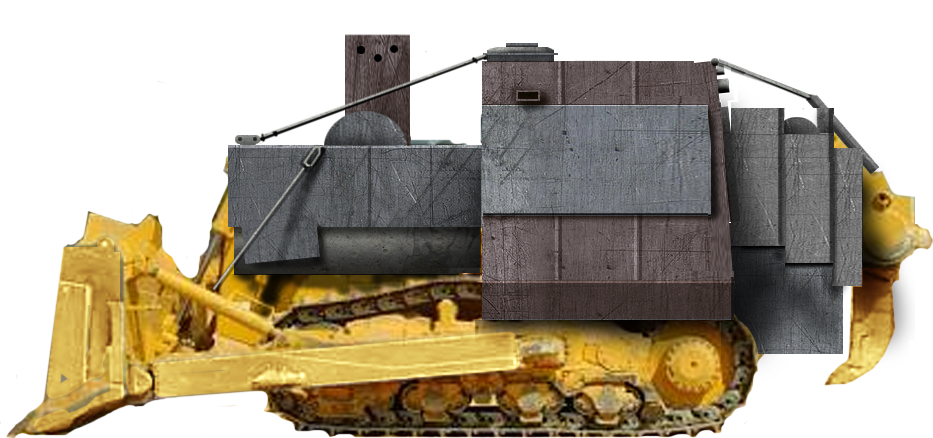You've probably heard about the Killdozer, but have you ever thought about it from an engineering perspective?

Here are a few other Shop Talk blog posts you might find interesting:
- Meet Hans and Franz, NASA's Monster Crawlers
- Monster Bulldozers by the Numbers
- Monster Excavators by the Numbers
Author’s Disclaimer: In this discussion of the infamous Killdozer, the author is focusing on the original dozer and the engineering aspects of its modification.
The Killdozer was a Komatsu D355A bulldozer (also called a crawler tractor) modified by Marvin John Heemeyer. The extensive modifications he made to the crawler bulldozer, which he had nicknamed the MK Tank, took place over approximately 18 months. The result of his work was a heavily armored bulldozer whose purpose was not material removal or handling but demolition instead.
Armored Bulldozers
The history of armored bulldozers can be traced back to World War II and CAT dozers used at the Battle of Normandy. The goal of dozers such as the Caterpillar D7 one shown was to clear obstacles, fill in bomb craters, and make roads accessible. Armored bulldozers, as well as armored excavators and compact track loaders, continue to be used for similar tasks.
By Post-Work: User:W.wolny - http://www.iwmcollections.org.uk/, Public Domain, https://commons.wikimedia.org/w/index.php?curid=440671
A careful review of armored construction equipment seems to indicate that the Killdozer was either based on the early armored dozers or the more modern Serbian military dozer.
By Alexmilt - Own work,
CC BY-SA 3.0, https://commons.wikimedia.org/w/index.php?curid=15793416
More modern armored bulldozers include CAT D7s and D9s, some designed specifically by Caterpillar under Caterpillar Defense Solutions. The CAT D7R-II is a medium bulldozer that includes various modifications including an armored cab, but none of these resemble the modifications seen on the Killdozer.
The Original Bulldozer
The Killdozer was modified from a 40-ton Komatsu D335A. Basic specifications from Construction Equipment Guide and RitchieSpecs tell us that it has a turbocharged 1175.4 cu in SA6D155-4A engine with 410 hp at 2,000 rpm. This dozer has 4 forward and reverse gears with a maximum speed of 7.9 mph. The D335A operating weight is almost 98,000 pounds. The height to the top of the cab is 12.5 feet while the length with blade and width over the tracks is 28.6 feet and 10 feet, respectively.
Killdozer Visibility
Five video cameras and three monitors provided Heemeyer with the view he needed to operate the bulldozer. The video cameras themselves were protected by 2 x ½” thick sheets of bullet-resistant Lexan polycarbonate sheets--enough to protect the cameras from being shot out by local law enforcement. Camera visibility was maintained by using compressed air nozzles positioned to blow away dust from the cameras.
Killdozer Cabin
The cabin of the Killdozer included air conditioning and onboard fans, with one of the fans located at the front of the cabin. Note that the air conditioning system proved to be the only opening in the armor that gave significant access. The cabin also contained the air tank used for blowing the dust away from the cameras and was located within the cabin on the driver’s left side. According to an archived article from the Rocky Mountain News, there was a box of Band-Aids, a back brace, two rolls of paper towels, two cans of starter fluid, a pair of locking pliers, and some unopened cans of Slimfast in the cabin as well.
Killdozer Armor

Graphical reconstitution of Marvin Heemeyer’s armored bulldozer by D Bocquelet. Provided courtesy of the creator at Tanks Encyclopedia.
The armor protecting the engine, cabin, and part of the tracks was comprised of 5,000 psi Quikrete contained between plates of 1/2” thick tool steel. Also protected were hydraulic lines and the radiator. In some areas, the thickness of the armor was over 1 foot.
It is believed he used a homemade crane found in his shop to hold the tool steel plate in place for welding. Note that welding tool steel can be challenging given the alloying materials and low carbon content present.
The Quikrete that was utilized is often used for patios, driveway aprons, deck supports, and sign footings. Quikrete recommends this particular type of concrete for projects that require 2” thick or more of high-strength concrete.
Once armored, the estimated weight of the dozer reached almost 49 tons, meaning that 9 tons of armor were added. To give some perspective, this is more than a standard school bus or average tractor weighs.
Comments on the Design
The Killdozer did have composite armor because of the layering of steel plate and Quikrete. The tool steel strength and stiffness absorbed most of the energy resulting from the impact of falling debris, gunfire, and explosives. Anything that made its way through the steel would have much less energy once it reached the concrete, and the concrete would absorb the rest.
The armor design effectively made this Komatsu bulldozer impervious to small arms fire and quite resistant to explosions, as evidenced by its resistance to over 2,000 rounds of ammo and three external explosions. In fact, the armor plates had to be cut open with an oxyacetylene cutting torch after multiple attempts with explosives failed.
Fate of the Killdozer
The Killdozer (including the armor and the Komatsu dozer beneath it) was cut into numerous pieces and sent to various scrapyards to prevent people from obtaining pieces as collector items or mementos.
Conclusion
The hydraulic track motors on the Komatsu did an excellent job of supporting the increased weight of the dozer and provided sufficient torque to keep the tracks turning. However, all final drive motors will eventually wear out. If you’re in the market for a replacement for a hydraulic motor, Komatsu or otherwise, let Texas Final Drive help you find a solution that will fit your budget and your needs.
Additional Resources:
- https://tanks-encyclopedia.com/marvin-heemeyers-armored-bulldozer/
- Killdozer the Book
- https://web.archive.org/web/20120315221635/http://www.thedenverchannel.com/news/4393800/detail.html
- https://web.archive.org/web/20080222044045/http://www.thedenverchannel.com/news/3394824/detail.html
- https://web.archive.org/web/20160405064359/https://www.highbeam.com/doc/1G1-120544009.html


